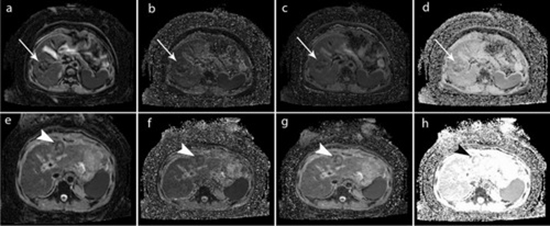] Prediction of hepatocellular carcinoma response to transarterial chemoembolization with intravoxel incoherent motion diffusion-weighted imaging

Background
There are several therapeutic options for hepatocellular carcinoma (HCC). As predicting the treatment response is critical in clinical decision making, we aimed to evaluate the quantitative intravoxel incoherent motion (IVIM) diffusion-weighted imaging (DWI) parameters as potential predictors of treatment response of HCC lesions to transarterial chemoembolization (TACE).
Results
Twelve patients (eight males; mean age, 56.12 ± 7.88) with 26 confirmed HCC lesions were recruited in the study. Thirteen lesions (50%) responded to TACE, and the remaining lesions were categorized as nonresponder. Age > 60 year (p value: 0.018), D (p value: 0.005), D* (p value: 0.005), and f (p value: 0.004) values were significantly different in response and nonresponse group lesions. Logistic multivariate analysis showed that f value (OR: 0.847 (95% CI 0.732–0.98), p value = 0.025) could independently predict tumor response to TACE. The ROC curve analysis showed f value could predict the HCC response to TACE with sensitivity and specificity of 76.9% and 76.9%, respectively.
Conclusions
IVIM-DWI parameters, especially the f value, might be useful for predicting the response of the intermediate-stage HCC to TACE.





ارسال نظر